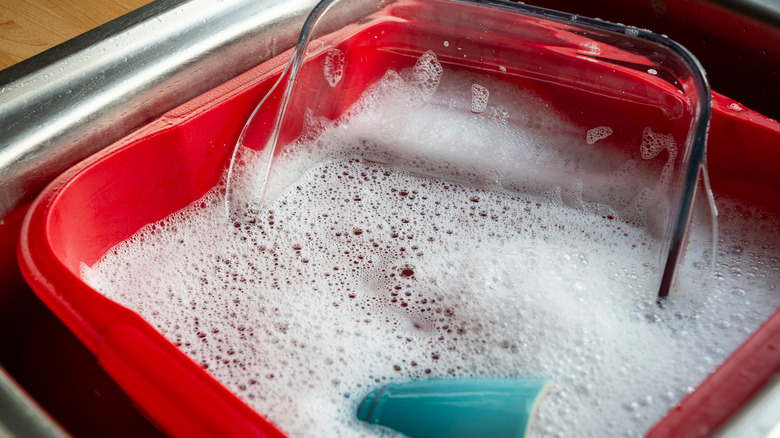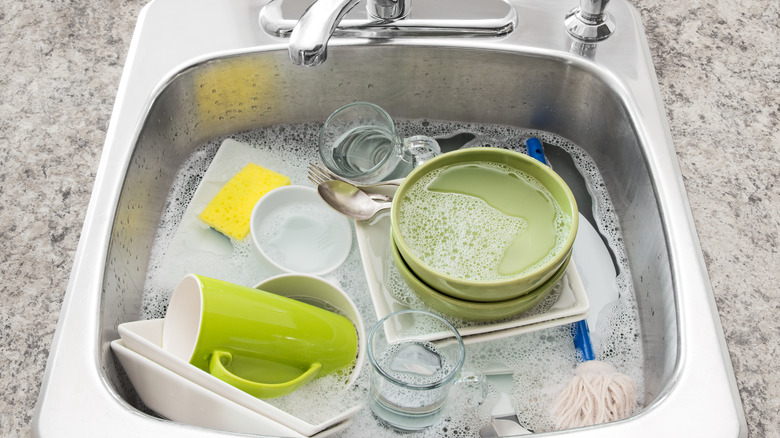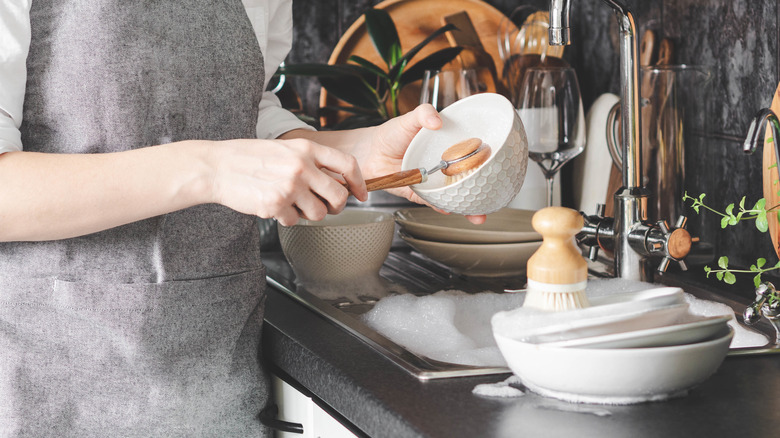What Is A Washing Up Bowl, And Do You Really Need One?
While Madge might have touted that Palmolive softens hands while you do dishes, some people would rather make the kitchen chore go more quickly. Although dirty dishes are unavoidable, many people are always looking for a kitchen trick, hack, or other timely advice to make quick work of that mess. Unless parents can enlist the kids to do it, both eco-friendly and cost-efficient cleaning methods can make those dishpan hands less noticeable.
In some households, a dishwasher is a well-used kitchen appliance. Instead of standing in front of the sink, stacks of plates, glasses, and silverware get rinsed, washed, and dried at the push of a button. There are both benefits and disadvantages of a dishwasher versus hand washing. From the amount of water used to efficiency, the dishwasher can be a winner. But, handwashing is vital for certain items, like knives or cast iron pans, or when the dirt and grime need extra care. Since the kitchen sink will always be a centerpiece of the room, shouldn't it be as efficient as possible? For some people in the UK, the best solution is the washing up bowl.
Is a washing up bowl just useless mucky water?
Rachael Ray might have made her countertop garbage bowl a staple on her show, but the idea of a washing up bowl might not be quite as popular. Although not the finger bowl featured on a high society British table, the common practice in the UK has been touted as a way to maximize the efficiency of a single-basin sink. The removable dish collector bowl holds all the dirty items. As Epicurious discussed, the concept might be a "cultural thing," but there are a variety of uses that could make it a viable purchase.
The washing up bowl can help with pre-soaking dishes, keeping fragile items from breaking in a sink, or even using less water than traditional dishwashing methods. In turn, there is a downside to this kitchen prop. The size can be large, which means it monopolizes the whole sink. Also, some people may not appreciate the dirty dishes and dirty water accumulating all day long. Basically, the decision comes down to personal preference. Just like some people would rather use a sponge over a rag, the washing up bowl has both its admirers and detractors.
Will a washing up bowl save people money?
From rising food costs to soaring utility bills, more consumers are seeking ways to stretch their budgets. Although water and electricity may be a necessity, the costs, in addition to the eco-friendly considerations, have some people looking for methods to reduce their usage across the board. Express UK asserts that a washing up bowl can help cut down on utility costs. From less rinsing water usage to reducing electricity consumption for heating the water, the publication asserts that the concept can be an overall money saver.
For those people who want to try the washing up bowl concept, there are several options on the market. A quick Amazon search shows many sizes and price points. Before making a purchase, it is best to understand sink dimensions, potential uses, and durability. As some people have mentioned, the washing up sink is often used for dishes, but it could have other purposes, like soaking delicate laundry items or bleaching toys. While this kitchen tool might not be as glamorous as a stand mixer or as "chefy" as a sous vide machine, the simple, old-school concept might have a multitude of uses waiting to be discovered.


